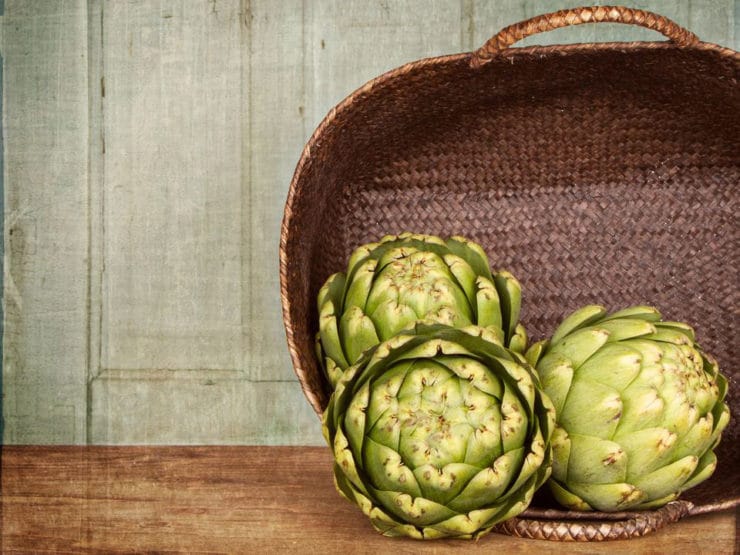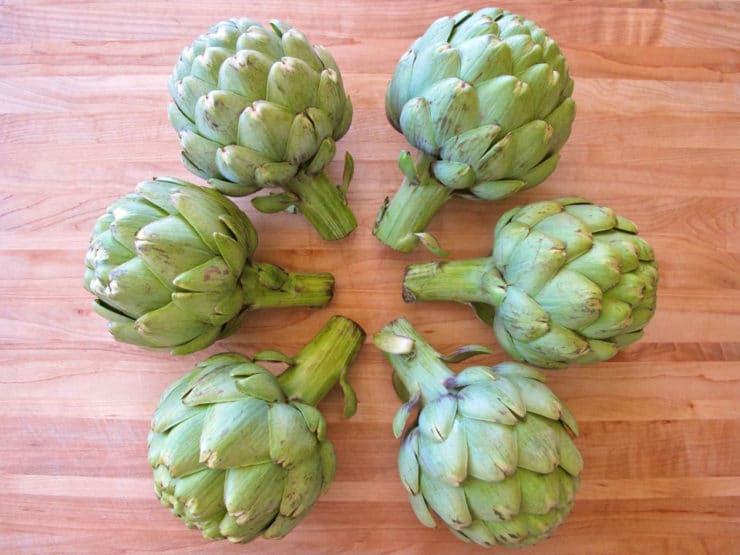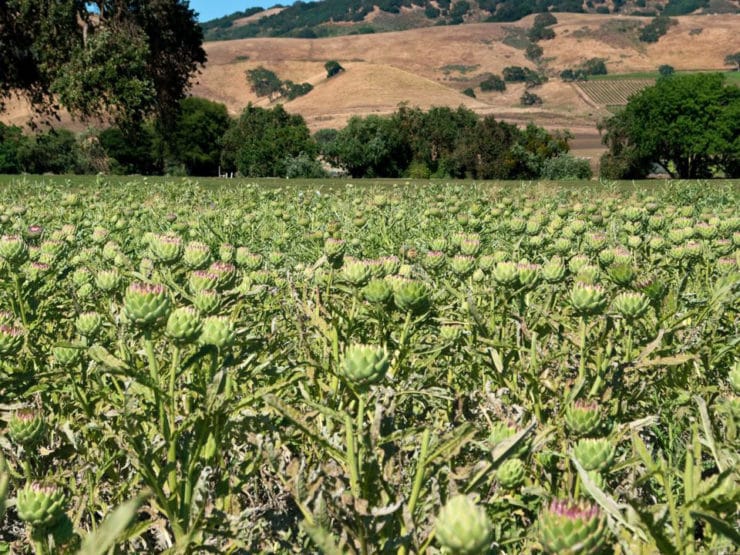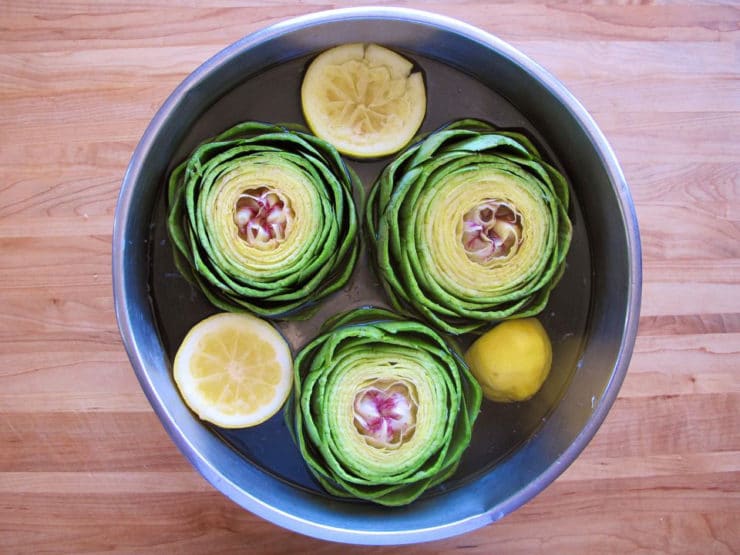
All About Artichokes – The ultimate artichoke guide – learn the history, plus tutorials for cleaning, prepping, and cooking in a variety of ways.
I grew up on the Central Coast of California, a peaceful stretch of countryside halfway between San Francisco and Los Angeles. At six years old, I started second grade at a brand new elementary school in our neighborhood. As part of the opening year festivities, students were asked to write an essay about something important to them. Those essays were sealed in an airtight canister and buried beneath the playground in a “time capsule” in hopes that a future generation would someday discover them. As a class, we thought long and hard about what our individual topics would be; after all, these essays would someday be unearthed and “discovered.” It had to be something important, something substantive and moving. In the end, I chose a subject that I felt passionate about… a topic that resonated with me on a deep, emotional level. I wrote about artichokes.
Looking back, I suppose it was sort of an odd food to obsess over. Artichokes are not exactly “kid friendly” vegetables. The strange, prickly, cactus-like plant might even cause one feel intimidated, but I’ve always loved them. Eating an artichoke is like hunting for buried treasure—scraping the leaves with your teeth, each one giving you a tantalizing taste of the sweet heart in the center. It takes work to get to that heart. Like anything worth having in life, the greater the challenge, the greater the reward. There is nothing so delicious as a tender steamed artichoke heart.

Artichokes are actually young, unopened thistle buds from the daisy family. If left to mature, the flowers can reach up to 5 feet in height. They are descendants of a similar thistle plant known as the cardoon, which can still be found thriving in the wild. Unlike cardoons, the artichoke is now exclusively cultivated for food. Its thick green petals, formally known as bracts or phyllaries, are topped with tiny thorns. The long stem has a fibrous, woody texture that resembles a young tree branch. It’s a very odd looking sort of thing. You would be hard-pressed to convince the uninitiated that it’s even meant to be food. And yet, when properly prepared, artichokes are a savory, delectable treat.
The exact origins of the artichoke are unclear. Culinary historians have debated over whether or not artichokes were enjoyed by the ancient Greeks and Romans, given mosaics that depict what appears to be the same thorny flower. These are now widely believed to be cardoons. Most historians agree that artichokes first appeared in the Mediterranean basin. Though we don’t know exactly when they became recognized as a food source, we do know that artichokes have been eaten by Jews for several centuries. The Talmud states, “one may trim the artichoke […] on a festival” for cooking. The ancient Israelites even had a special unit of measurement for artichokes called kundasa. By the 11th century, after the Moors began cultivating them in Spain, artichokes were adopted by Sephardic Jews.

There are now over 50 varieties of culinary artichokes in the world, but here in America we are most familiar with the Italian green globe variety. Earlier this year, I was thrilled to hear that the artichoke was chosen as California’s official “State Vegetable”—fitting, since my home state supplies 100% of the globe artichokes available commercially in America. The artichoke’s journey to California began on the East coast where French allied soldiers introduced them to America during the Revolutionary War. Globe artichokes began appearing in Virginia around the 1720s. In California, the artichoke was not seen as a favorable cash crop until the 1890s, when Italian farmers in Half Moon Bay planted them. By 1904, they were filling boxcars with artichokes to send to the East coast. In 1922, the Italian farmers moved their artichokes to California’s Salinas Valley, where they have been growing ever since.
There are many ways to prepare artichokes. They can be steamed, boiled, grilled, and even fried. I grew up eating boiled artichokes, but have since learned that steaming produces a more predictable result. Smaller baby artichoke hearts, available in cans or jars (and seasonally available fresh during May/June), can be used in salads and sautés. Marinated baby artichoke hearts are particularly popular as a pizza topping and in salads. Larger artichokes can be served raw or cooked as an appetizer, side or entree, and are best served with a sauce to compliment their flavor. I have created photo tutorials for some of the most common large artichoke preparations, which I have linked to below. I’ve also linked to a special fried Jewish Italian artichoke recipe that is beyond delish. Highly recommended. Next spring I’ll share some tutorials on baby artichokes.
No matter how you serve them, artichokes are pretty much the best thing ever. It’s true! Just ask my second grade self. What’s your favorite way to eat artichokes?

ARTICHOKE TUTORIALS
Cleaning, Steaming and Eating Artichokes
Preparing Raw Artichokes for Salad
Separating the Heart from a Raw Artichoke
ARTICHOKE SAUCES
Vegan Saffron Hollandaise Sauce
Note: Strictly kosher Jews have their own guidelines for cleaning and consuming artichokes, which differ from the tutorials that appear here.
—
Research Sources
Greenspoon, Leonard J. (2005). Food and Judaism. Creighton University Press, US.
Marks, Gil (2010). Encyclopedia of Jewish Food. John Wiley & Sons, Inc., Hoboken, NJ.
Smith, Andrew F. (2007) The Oxford Companion to American Food and Drink. Oxford University Press, UK.
Sonnante, Gabriella; Pignone, Domenico; Hammer, Karl (2007). The Domestication of Artichoke and Cardoon: From Roman Times to the Genomic Age. US National Library of Medicine National Institutes of Health, Annals of Botany, n.d. Web. 23 Apr. 2013.
Toussaint-Samat, Maguelonne (2009). A History of Food. John Wiley & Sons, UK.
Wright, Clifford A. (2001). Mediterranean Vegetables. The Harvard Common Press, Boston, MA.
Wright, Clifford A. (2009). Did the Ancients Know the Artichoke? Gastronomica: the Journal of Food and Culture, vol.9, no.4, pp.21–28, n.d. Web. 17 Jul. 2013.
We are a participant in the Amazon Services LLC Associates Program, an affiliate advertising program designed to provide a means for us to earn fees by linking to Amazon.com and affiliated sites. As an Amazon Associate I earn from qualifying purchases.
Other Great Recipe Ideas
Weelicious: Artichokes with Lemon Yogurt Sauce
The Pioneer Woman: Spinach Artichoke Pasta
Taste with the Eyes: Artichoke, Spicy Tomato Broth, Two Ways
Kalyn’s Kitchen: Baked Artichoke Hearts Au Gratin



Hummus artichoke is very good
ty
Stuffed artichokes or artichoke dip
Steamed, then picked apart and leaves dipped in mayonnaise and butter….oh, and sprinkle with a little salt and white pepper. Been doing that way since I was a kid at my grandparents´ in California. YUM!
Yay! Can´t wait to do the grill!
thanks for doing this, it is indeed a labour of love
Stuffed with cream cheese, onions and capers and deep fried.
I like mine with a saffron mayo
I´d still like to know who thought ´let´s eat one of these!´ seems the most unlikely vegetable – but I LOVE them – thank you!
Yummmmm…..
AWESOME! I LOVE ARTICHOKES!!! THANK YOU!
Did they ever open that time capsule? Love artichokes!
I love these,
Guess what I am making for shabbos? I will give you a hint, Artichokes
Thanks for posting this! I really do appreciate it…this coming from a huge artichoke fan!!
I love artichokes, especially when someone else cooks them….
YAY!!!!! Oh Tori, I LOVE your food blog and recipes and I LOVE artichokes!!! THANK YOU!!!!! (I made your baba ganouj recipe on Monday and love it! )
Thank you!!
thank you so much:-)
I just had some amazing artichoke from a local deli here in NJ..stuffed, breaded and fried..not sure of the stuffing but I did taste cheese…they were out of this world..